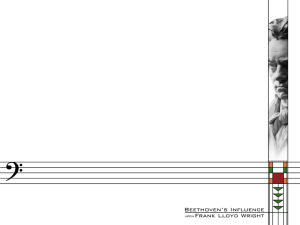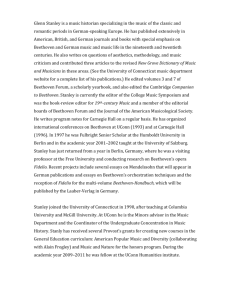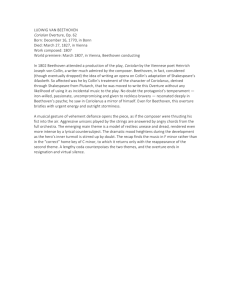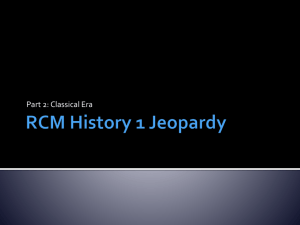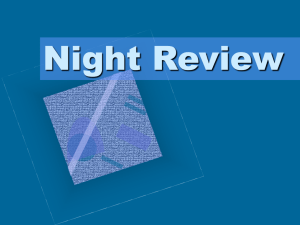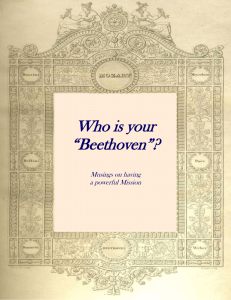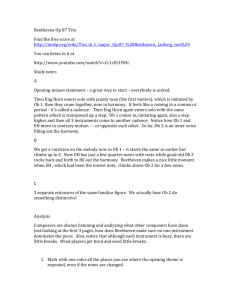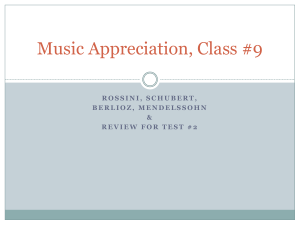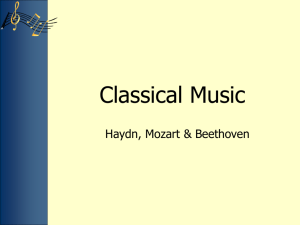Music Appreciation, Class #9
advertisement
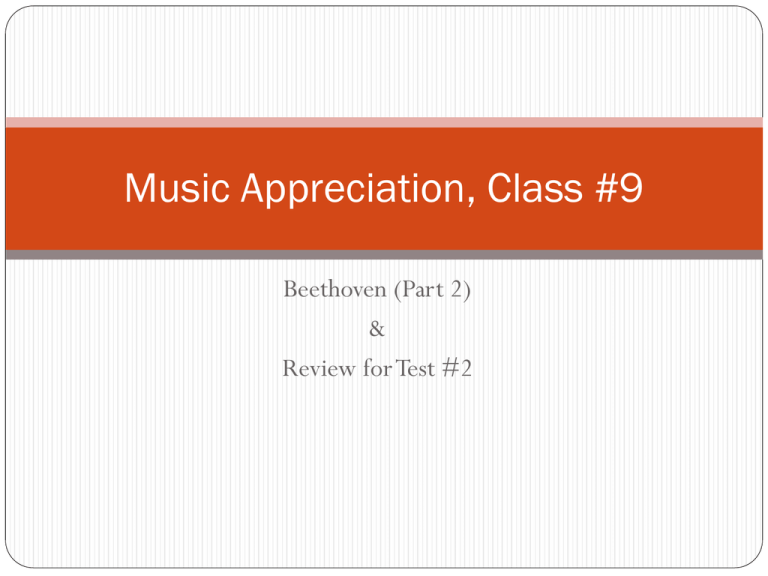
Music Appreciation, Class #9 Beethoven (Part 2) & Review for Test #2 Where we left off… 1812-1817 Health Public performances/appearances Stylistic crisis? Caspar, Karl and Johanna 1. Health crisis Liver disease Hearing loss 1818 Public performances 1814: last public appearance as a pianist 1815: last public appearance as a conductor Exhausted musical possibilities? 2. Family crisis Kaspar van Beethoven Died November, 1815 Johanna van Beethoven (widow) Karl van Beethoven (son) Trial 1815-1820 Court for commoners vs. Court for nobility “Van” vs. “Von” Evidence? Karl’s birth (4 months) Ludwig’s victory Karl’s reaction (1826) Why? 3. Romantic Crisis “Immortal Beloved” letters Recipient? Three possibilities Dated 1812-14 Among his papers? 3. “Immortal Beloved” …so near! so far! Is not our love truly a heavenly structure, and also as firm as the vault of heaven? … …Your love makes me at once the happiest and the unhappiest of men… …I can live only wholly with you or not at all -Yes, I am resolved to wander so long away from you until I can fly to your arms and say that I am really at home with you, and can send my soul enwrapped in you into the land of spirits … Final musical period Reflection 1816-1827 Spiritual Bach Contrapuntal “The Age of Enlightenment” is replaced by “Romanticism” Emotion over thought Why? 9th Symphony Composed between 1817-1824 1st major Beethoven premiere in almost 12 years Three standard movements New: 4th movement: “Choral” “An Die Freude” (“Ode to Joy”) Friedrich Schiller, 1785 Passé ideas and ideals Brotherhood Equality Justice Liberty Beethoven’s purpose Conflict/instability vs. Resolution Confrontation of evil Unable to resolve the recapulation! Military Triumph over petty decisiveness Intellectual vs. spiritual vs. emotional struggle Themes/Beethoven’s beliefs Humanity Children of God Spiritual vs. religious Universality Love (romantic and platonic) Redemptive Inspirational Translation O friends, no more these sounds! Let us sing more cheerful songs, More full of joy! Joy’s magic power re-unites all that custom has divided, all men become brothers, under the sway of thy gentle wings. And the cherub stands before God! Gladly, like the heavenly bodiesWhich He sent on their courses Through the splendor of the firmament;Thus, brothers, you should run your race, like a hero going to victory! You millions, I embrace you.This kiss is for all the world! Brothers, above the starry canopy There must dwell a loving father. Do you fall in worship, you millions?World, do you know your creator? Seek Him in the heavens; He must live above the stars Only Two Rehearsals Requirements Two orchestras Two choruses = four conductors Four soloists Complaints Cross-town rivals Musical difficulties New technical demands Rewrites and edits Beethoven’s week Rental (Inflation) Theater Orchestra Chorus Soloists Copyists Ticket sales Health May 7, 1824 Social/musical event Beethoven’s long absence Rumors Conductor? 1st Violinist Applause “Immortal Beloved” 1994 Historical fiction Premiere of the 9th Fall of the Berlin Wall December 25, 1989 Leonard Bernstein International orchestra, chorus, soloists "Joy" (Freude) changed to "Freedom" (Freiheit) in the text sung Worldwide live telecast Video? Beethoven’s Death Final days Cures Monday, March 26, 1827 Legend Funeral March 29, 1827 20,000 Viennese mourners Pallbearer Franz Peter Schubert “Blessed be the first one among us to follow Beethoven to the grave.” Ferdinand Hiller Ferdinand Hiller (16) Prominent Jewish family Cultured Musical Social Friendships Johann Wolfgang von Goethe Felix and Fanny Mendelssohn (Bartholdy) “Beethoven’s Hair” Russell Martin Three stories in one Beethoven’s biography History/journey of the locket Nazis in Vienna and Denmark DNA testing and results The Locket with Hiller’s inscription Close-up Of The Locket Extraordinary Beethoven web sites San Jose State University http://www.sjsu.edu/depts/beethoven/ “Beethoven’s Hair” http://www.beethovenshair.ca/ Help! Test #2 Review November 6, 2008 CD Tracks Cumulative New tracks Sample review questions What were the most important changes made to the piano during the Classical era? What enormous political/social event was celebrated with a performance of the Beethoven 9th in December 25, 1989? At the end of his career, Haydn wrote his first and only oratorio. It is a highly descriptive telling of Holy Scripture from Genesis and the Psalms. What is the name of this piece? Compare Haydn’s years with the Esterházy family vs. Mozart and his employers. What was the tradition known as DROIT DE SEIGNEUR? What are the “Sketch Books”? What are “Conversation Books”? What city was the musical and cultural center of the Classic period? The exposition of Beethoven’s 5th Symphony contains how many notes? How does the overture to Mozart's Don Giovanni end? Beethoven violently changed the dedication of the “Emperor” concerto to the “Eroica” concerto in December 1804. Why? Thousands of Viennese attended Beethoven’s funeral. Among his pallbearers was what great composer and Beethoven devotee? Why is the Classical Period also known as the “Age of Reason” or the “Age of Enlightenment”? Mozart was unusually proud of which two specific scenes in The Marriage Of Figaro. Why? What is Don Giovanni’s fate? Is he dragged to Hell, or does he alone make the decisions which determine that fate? In what way is that revolutionary? Who was Lorenzo Da Ponte? Why was he hired to work in Vienna? Da Ponte promised Emperor Franz Joseph a major change in Beaumarchasis’ radical play The Marriage Of Figaro in order to obtain permission to work with Mozart on the project. What was Da Ponte’s promise, and did he keep it? What is THE HEILIGENSTADT LETTER? Who was Antonio Salieri? Facts vs. fiction, please! How and when did the myths about him and his relationship to Mozart begin? What Tony and Academy Award winning play and movie tells that story? What is “Chamber Music”? What composer is credited with the greatest accomplishments in Chamber Music? How many musicians are required for Chamber Music? Did Beethoven write and re-write his music or did he compose seemingly without effort? The writers, poets and playwrights of the Classic period worked with what cultural and aesthetic goals in mind? Did Mozart’s talent require training? What proof was recorded of his talents? “Music, of all the arts, has the greatest influence over the passions....The Marriage of Figaro contains all of the elements of the French Revolution” When did Beethoven’s hearing begin to fail? Why? Why have the facts recently changed? The excavation of what two major cities marks the birth of the Classical Period? Why is Haydn considered to be the “Father Of The Symphony”? “Papa Haydn”? How many movements are standard in a Classical concerto? Which tempo scheme is standard for a Classical concerto? Between 1812 and 1817 Beethoven composed almost no music. Three crisis interrupted his musical concentration. What were those three events? Mozart once wrote to his father that he was really only interested in writing one genre and that all his other compositions were just to generate income. What is that one genre? What is the “surprise” in the “Surprise Symphony” by Haydn? Why did he feel the need to surprise his audiences? How did he accomplish the surprise? Essay Questions Explain how Susanna (The Marriage Of Figaro) and Leporello (Don Giovanni) are radical characters and thereby symbolic of the entire Classical period. Your answer must include a discussion of the musical and social/political implications each character presents. What did Ferdinand Hiller do on May 27, 1827? What was the fate of the locket? How has the history of Beethoven’s final years changed as a result? Where is the largest collection of Beethoven artifacts housed today? Describe Beethoven’s week of May 1-7, 1824 in detail, including the premiere of the 9th. Identify and label each section of the Sonata form in detail. Draw a diagram of the finale of Act II of Marriage Of Figaro showing the continuum of new characters and new plot twists. Characters names are: Antonio, Bartolo, Basilio/Curzio, The Count, The Countess, Figaro, Marcellina, Susanna. Then explain TWO ways in which the finale of Act II of Marriage Of Figaro was a revolutionary act. New York Philharmonic Three tickets left!
